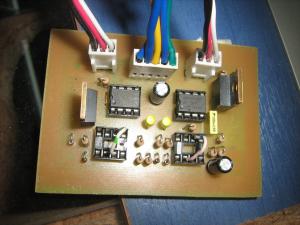
|
 Home Home
 Projects Projects
 Experiments Experiments
 Circuits Circuits
 Theory Theory
 BLOG BLOG
 PIC Tutorials PIC Tutorials
 Time for Science Time for Science
|
| ||
|
26 January 2010 Author: Giorgos Lazaridis PC System Health MonitorWorklog - The results from the cabinet change (March 20 2010) I let the system running non-stop for about a month or more. The following images are taken with many days difference between each other:
The system runs super-stable. The three HDDs are from 4 to 5 degrees above ambient temperature, ranging from 26 to 29 degrees. The 4th HDD is all the time 2 degrees above ambient temperature. No it has nothing to do with the location or the usage of the HDD, i test it myself. This HDD is a Western Digital -GREEN HDD. I can only say that... yes... the GREEN technology works!. 50% thermal load reduction! The temperature difference between the inlet and the outlet is between 1 to 3 �C. Moreover, the North lane and South lane seems to have up to 1�C difference, which is something that i really did not expect. The PSU is no more a significant thermal load. After all, the air outlet of the PSU is directly before the outlet of the box. The heavier thermal load comas from the CPU. About 13 - 14 degrees above ambient. I did not measure temperatures above 36 degrees. Taking into account that my CPU is designed to operate in temperature ranges between 5 and 71.4 degrees, the 36 degrees is like my CPU is near the seaside drinking cocktails. What i did notice though, is that i had many rpm ups and downs. Also, one of my inlet fans stalled once. That was a sign from above, telling me to "Change the rpm control method of the inlet fans". If you have read the article from the beginning, i run these fans with averaging a PWM frequency, rather than sending PWM pulses directly to the fans. The circuit that i used for these fans is located here. I need to make some changes. First of all, i will remove the averaging capacitors C4 and C8. Maybe, i will completely remove the circuitry around the 741 and the 741 itself, and leave only the zener and R7. Then i will change the firmware of the PIC. I tried my best to find a method to control 3-wire fans and have also rpm feedback out of it. I will BLOG my experience and explain the various ways i tested. The final (i hope) firmware version will use pulse stretching. BACK TO THE LAB! ... two days later (March 20 2010) So, a couple of days later, i had everything ready. I uploaded the new firmware to the PICs. Also, i removed the 741 OP-AMPS from the circuit. Although they did not cause any problem, They did not help at anything. The pulse stretching method just works! The new circuit is according to this PWM 3-Wires Fan Controller with RPM feedback (Pulse Stretching Method). I also removed the annoying capacitors that i used before for averaging the voltage. Now the fans are powered with pure PWM. The great thing is that from 800rpm (that i take as minimum) up to 1800rpm (the maximum of the fans), there are about 80 speed steps! Well, i do not think that this is a practical advantage, i mean 10 steps would be enough, but hey, better more than less. I did not mount the circuit on a new PCB. Instead, i hacked my old PCB. I un-soldered the capacitors, removed the 741 from its bases and bridged the pin 2 with the pin 6 (reverse input and output pin) of the 741. The following photo indicates the hacked PCB: (the original PCB is located here) 
Now the same story again. I will let the system operate for a week or so. During this time, i will note and correct any flaws or bugs. I am not sure if i will make a new PCB - lighter than the existing one. If this one works, i will let it as-is. But from the very first hour of operation, i can see that the operation is dramatically improved. The input fans have almost the same rotation speed without asymmetries. The operation is smoother and the rpm change (whenever needed) is always successful - slower though, but this is not a problem after all. Comments
|
|
 Contact Contact
 Forum Forum
 Projects Projects
 Experiments Experiments
 Circuits Circuits
 Theory Theory
 BLOG BLOG
 PIC Tutorials PIC Tutorials
 Time for Science Time for Science
 RSS RSS
Site design: Giorgos Lazaridis © Copyright 2008 Please read the Terms of services and the Privacy policy |